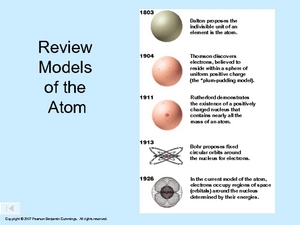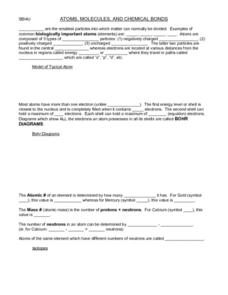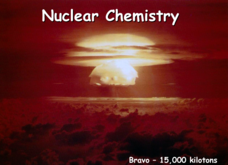Atomic Nucleus Teacher Resources
Find Atomic Nucleus lesson plans and worksheets
Showing 271 resources
Curated OER
Atoms and the Periodic Table
Familiarize your new chemists with the periodic table of elements by contemplating this collection of slides. Element groups are identified, atoms are defined, and nuclide notation is explained. Isotopes are also mentioned. The topics...
It's About Time
What Determines and Limits an Atom's Mass?
Provide learners with the tools to further understand nuclear energy and isotopes. Young chemists investigate the components of an atom's nucleus, use symbols to represent various isotope forms, and use the percent abundance of an...
Curated OER
Nuclear Reactions
Starting with a recap of atomic structure, these slides continue by comparing different isotopes of uranium and explaining which are stable and which have a decay period and emit alpha or beta particles. Gamma decay is just mentioned on...
Mr. E. Science
Atoms and Bonding
I don't trust atoms because they make up everything. Budding scientists learn about famous scientists connected to atomic models, chemical, ionic, and hydrogen bonds. The presentation also presents how to count atoms...
Curated OER
Review Models of the Atom
Multiple representations of the varying theories of atomic structure. With these pictures and some background of the theories and scientific figures surrounding them, your class will develop a better understanding of scientific history...
Curated OER
Atoms, Ions and Formula Basics Make-up Test
Using a copy of the periodic table, chemistry test takers fill in a chart with element name, chemical symbol, atomic number, atomic mass, and numbers of subatomic particles. They define subatomic particles, draw atom models, explain...
Veritasium
What Are Atoms and Isotopes?
Atoms may make up everything, but what are they made of? The narrator asks patrons at a local park what atoms are in an interview-style video. He then creates an atomic model and adds a neutron to it, opening the discussion to isotopes.
Curated OER
Atoms, Molecules, and Chemical Bonds
In this atoms worksheet, students review the parts of an atom, Bohr diagram, atomic number, mass number, and covalent bonds. This worksheet has 5 drawings and 26 fill in the blank questions.
Curated OER
Atomic Models
Students explain scientists' ideas about the structure of the atom over the last century. They develop a pictorial history of the changing ideas about the atom and write a caption describing the scientific thinking behind the model.
Curated OER
Atoms
In this atoms worksheet, students circle the term in parentheses that makes the 20 statements correct. The statements review the parts of an atom, isotopes, and basic matter principles.
Curated OER
Why Do Atoms Combine?
In this atom worksheet, students will complete 8 fill in the blank statements based on the different parts of an atom. Then students will explain how the arrangement of electrons in an atom is related to the periodic table.
Curated OER
Exploring Atoms
In this chemistry worksheet, students complete 29 fill in the bank questions about atoms based on the movie Exploring Atoms from the website www.brainpop.com .
Curated OER
Chemistry - Science 10
In this chemistry science worksheet, students identify the parts of a chemical reactions. Students name the major particles of the atom. Students apply knowledge about the atom, theories, and models.
Cornell University
Isotope Rummy
Thanks to this game, teaching isotopes will never be the same. Physical science scholars work their way toward understanding isotopes in an entertaining game. Pupils play rummy in groups while practicing good sportsmanship and creating...
Science Geek
Nuclear Chemistry
Which bichemicals wash up on shore? Nucleotides! Presentation covers alpha, beta, and gamma radiation. Includes a comparison of fission versus fusion. Presentation is the second in a five-part series.
Virginia Department of Education
Historical Models of Atoms
What does the past have to do with today? Young scientists find that answer as they learn more about past chemists and their significant contributions to the field. Pupils use the Internet to research historical figures...
Virginia Department of Education
Isotopes
Lead your class through the amazing world of isotopes as they investigate the various properties they contain and further understand their respective location on the periodic table. They explore half-lives and radioactivity as each...
TED-Ed
The 2,400-Year Search for the Atom
From ancient Greek philosophers to early American Quakers, people have sought to understand the composition of matter for millennia. Follow along with this video as it explores the long scientific journey that eventually led to the...
Curated OER
What Do Atoms Look Like?
In this atomic structure worksheet, students answer eleven short answer questions about the structure of atoms including the number of protons, neutrons and electrons. Students indicate the differences in isotopes of atoms and what the...
Curated OER
Bohr Model Diagrams
In this Bohr model diagram worksheet, students draw the Bohr diagram for 6 elements. They show the number of electrons in each energy level and the total number of protons and neutrons in the nucleus.
Curated OER
Chemistry Review
In this chemistry review activity, students read about atoms and the periodic table and they complete a chart using the periodic table to find the atomic number, atomic mass and group of given elements. Students answer 5 questions about...
Curated OER
Periodic Table Basics Review Sheet
In this periodic table activity, students complete a chart with the appropriate element symbol, the atomic mass and the atomic number. They classify elements by their groups and as metals, nonmetals or semi-metals. They also answer two...
Curated OER
Matter, Matter
Students define vocabulary related to the parts of the atom. In this matter lesson, students navigate the web to find the structure and the forces that affect atoms. Students complete an experiment with positive and...
Curated OER
Modeling Atoms
Students create an atomic model using a computer program. In this technology instructional activity, students identify the difference between radius and diameter. They create circular patterns and spheres based on certain specifications.

























